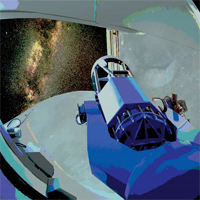ChiVO at SPIE Astronomical Telescopes + Instrumentation 2014
SPIE is a not-for-profit international professional society for optics and photonics technology, founded in 1955. It organizes technical conferences, trade exhibitions, and continuing education programs for researchers and developers in the light-based fields of physics, including, but not limited to: optics, photonics, and imaging engineering.
Eight engaging plenary talks are among the highlights anticipated by those planning to attend SPIE Astronomical Telescopes + Instrumentation 22-27 June at the Palais des congrès de Montréal. The most prestigious event for developers of ground- and space-based telescopes, the supporting technologies, and the latest instrumentation draws attendees from throughout the global community.
This year CHIVO will expose three papers:
Chilean Virtual Observatory services implementation for the ALMA public data
"The success of an observatory is usually measured by its impact in the scientific community, so a common objective is to provide transparent ways to access the generated data. The Chilean Virtual Observatory (ChiVO), started working in the implementation of a prototype, in collaboration with ALMA, considering the current needs of the Chilean astronomical community, in addition to the protocols and standards of IVOA, and the comparison of different existing data access toolkit services. Based on this efforts, a VO prototype was designed and implemented for the ALMA large scale of data."
Chilean Virtual Observatory and Integration with ALMA
"The Virtual Observatories strive to interoperate, exchange data and share services as if it was only one big VO. In this work, the state of the art of VOs will be presented and summarized in a schematic diagram with the frequency range of the observed data that every VO publishes. Chile, currently a member of the IVOA, collaborates with the Atacama Large Millimeter/submillimeter Array (ALMA), to study and propose ways to adequate the data generated by ALMA to the different data model proposed by the IVOA."
Automatic detection and automatic classification of structures in astronomical images
"The study of the astronomical structures is important to the astronomical community because it can help to identify objects, which can be classified based on their internal structure or their relation to other objects. For this reason, it is developed an automated tool to analyze astronomical images into its components. Firstly, a 2D images is decomposed into different spatial scales based on wavelet transform. Then, it is implemented a detection algorithms to each spatial scale, such as Clumpfind, Gaussclump, or Dendrogram techniques. The goal is to build a new algorithm and tool that is available to the community and satisfies the requirements of the next Chilean Virtual Observatory (ChiVO)."
For reports on technical talks, photos, and videos please follow spie.org.
Authors:
Chilean Virtual Observatory services implementation for the ALMA public data
Jonathan Antognini a, Mauricio Solar a, Jorge Ibsen f, Mauricio Araya a, Lars Nyman f, Diego Mardones b, Camilo Valenzuelaa, Patricio Ramirez a, Christopher Fernandez a, Mario Garces a
Chilean Virtual Observatory and Integration with ALMA
Mauricio Solar a, Walter Fariña a, Diego Mardones b, Jonathan Antognini a, Karim Pichara c, Neil Nagar d, Victor Parada e, Jorge Ibsen f, Lars Nyman f, José Marroquin a
Automatic detection and automatic classification of structures in astronomical images
Rodrigo Gregorio a, Mauricio Solar a, Diego Mardones b, Karim Pichara c, Ricardo Contreras d, Victor Parada e
Institutions:
Universidad Técnica Federico Santa María, Av. España 1680, Valparaíso, Chile.
Universidad de Chile, Camino el Observatorio 151, Santiago, Chile.
Pontificia Universidad Católica de Chile, Av. Vicuña Mackenna 3939, Santiago, Chile.
Universidad de Concepción, Víctor Lamas 1290, Concepción, Chile.
Universidad de Santiago de Chile, Av. Ecuador 3659, Santiago, Chile.
Atacama Large Milimeter/submilimeter Array, Alonso de Cordova 3107, Santiago, Chile.

